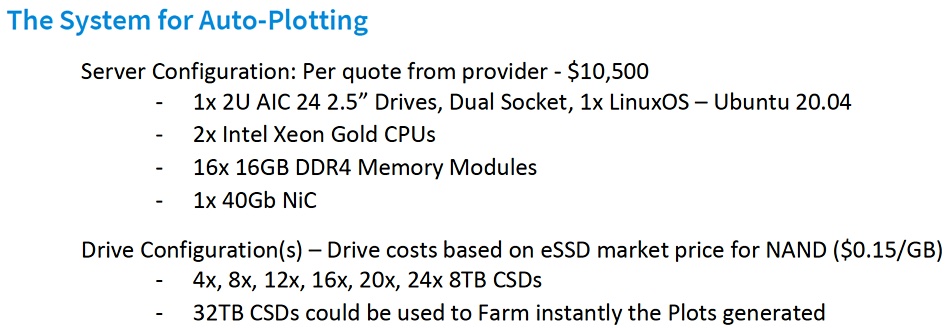Compute-in-storage developer NGD Systems says Chia farmers can use its drive-level CPU and DRAM to compute plots faster than with a host CPU on its own.
Chiacoin is a Bitcoin-like cryptocurrency, based on mining or farming of proof-of-space-and-time using hard disk drives and SSDs. The proof is that an amount of disk or SSD capacity — a computed “plot” — is actually used to store some specific data at a specific time.
The more plots a Chia farming system has, the likelier it is to be awarded (win) Chiacoin as the Chiacoin blockchain extends and needs new plots with specific values. A Chia FAQ explains: “Users of the Chia blockchain will ‘seed’ unused space on their hard-disk drive by installing software which stores a collection of cryptographic numbers on the disk into ‘plots’. These users are called ‘farmers’. When the blockchain broadcasts a challenge for the next block, farmers can scan their plots to see if they have the hash that is closest to the challenge.”
A plot is computed using a space parameter defined as an integer called k, and the default option is k=32. A k32 plot is 101.4GiB (108.9GB) in size.
A completely full 10TB disk drive can store 91 x 108.9GB plots. An 18TB HDD could store 165 such plots.
The standard Chiacoin farming system is a server with disk drives and/or SSDs. Disks are slower to access than SSDs, but SSDs wear out from repeated writes. Sustained plotting throughput on a SATA hard disk drive is 200MB/sec. It is 550MB/sec with a SATA SSD and 3000MB/sec with an NVMe SSD.
According to PC Gamer, a 2TB disk drive could be entirely used up in Chia farming in 160 days, and a 512GB SSD in 40 days. A 1TB SSD lasts 80 days. That’s because the SSDs wear out from the repeated drive writes. NGD’s draft white paper reads: “Each plot is relatively small, ~100GB; however, creating the plot requires up to 1.3TB of raw data writes. … each plot is created, read, modified, written, and repeated until it reaches a final plot. This creates a time/wear/speed issue for the initial setup of the farm. Once the plots are in place, farming becomes a ‘stay online and available’ process.”
An NGD Systems blog by VP Marketing Scott Shadley discusses Chia plotting. He writes “A plot today takes roughly 100GB of storage space, while it can create up to 400GB of writes.”
Plotting consumes up more CPU resources at some points in the plotting cycle than others. So when computing multiple plots at once — concurrent plotting — it should be done with the heavy-use CPU periods on the different plots run at separate times, staggered. Shadley writes: “Concurrent staggering of plots on a SATA SSD can take over 96 hours.
He suggests using NGD’s compute-in-storage Newport drives with the drive CPU executing the plotting algorithm. That will, in principle, shorten the overall plot times. An NGD Newport 32TB SSD can hold up to 300 plots and withstand the wear rate involved in the plotting. That’s far more plots than an 18TB HDD can store.
A second Shadley blog/article on LinkedIn goes deeper into this, and discusses drive auto-plotting: “NGD systems offers drives that can ‘Auto-Plot’ by using the OS and Memory embedded in our Solid State Drives (SSDs) to add plots to the drives while the host is also plotting. Concurrent plots that do NOT get in the way of each other and that have independent resources.”
The drive auto-plot time will be longer than a server CPU plot time, but concurrent and non-staggered processing, Shadley says, means you can grow the size of your Chia farm faster, and more cheaply, than by buying high-speed processors such as an AMD Ryzen Threadripper 3900 that can cost over $6000.
He asks: “What is the value you need to see the net benefits here? Ten per cent, 20 per cent, 40 per cent? Well, we have data that shows all of these based on the system used, the drives bought, the size of drives and the work being done.”
A draft NGD white paper discusses a sample configuration [see below]: “With 4 x 8TB Auto-Plotting CSDs and looking at a month of Plotting, you will see that for this configuration, the plot count increases by more than 100 plots, at NO Expense, Cost or Work, by the Host.”

This configuration generated 2514 host-only plots, but 2617 host+auto-plotting plots — 103 more. The host+auto-plotting total scales pretty linearly, as more NGD drives are added, with up to 24 tested:

All this is a neat bit of tactical marketing by NGD, as it sees a whole new niche for its computational storage. It’s preparing a white paper on the topic. Check out NGD’s Chia web page for more information. The white paper should be out shortly.








